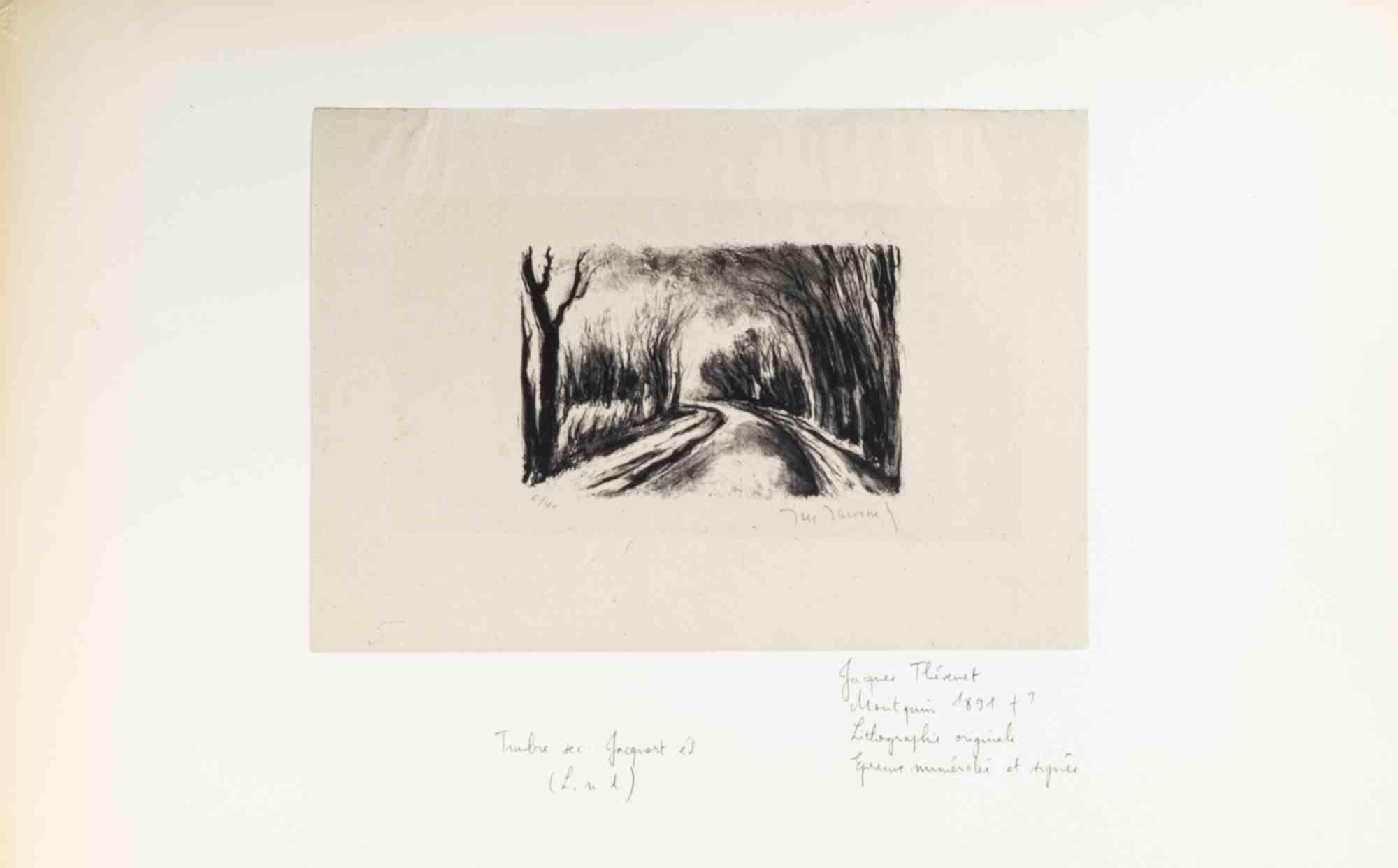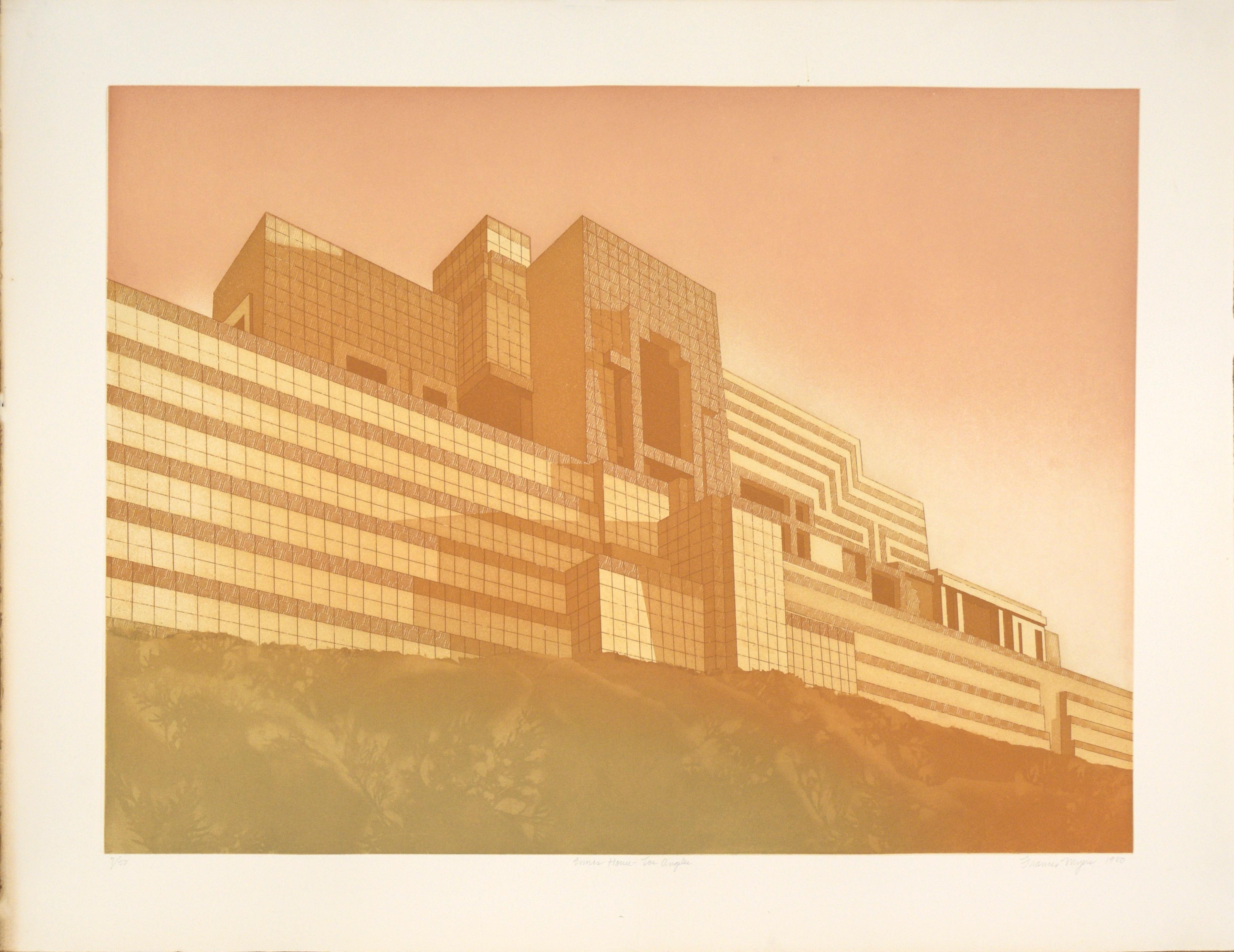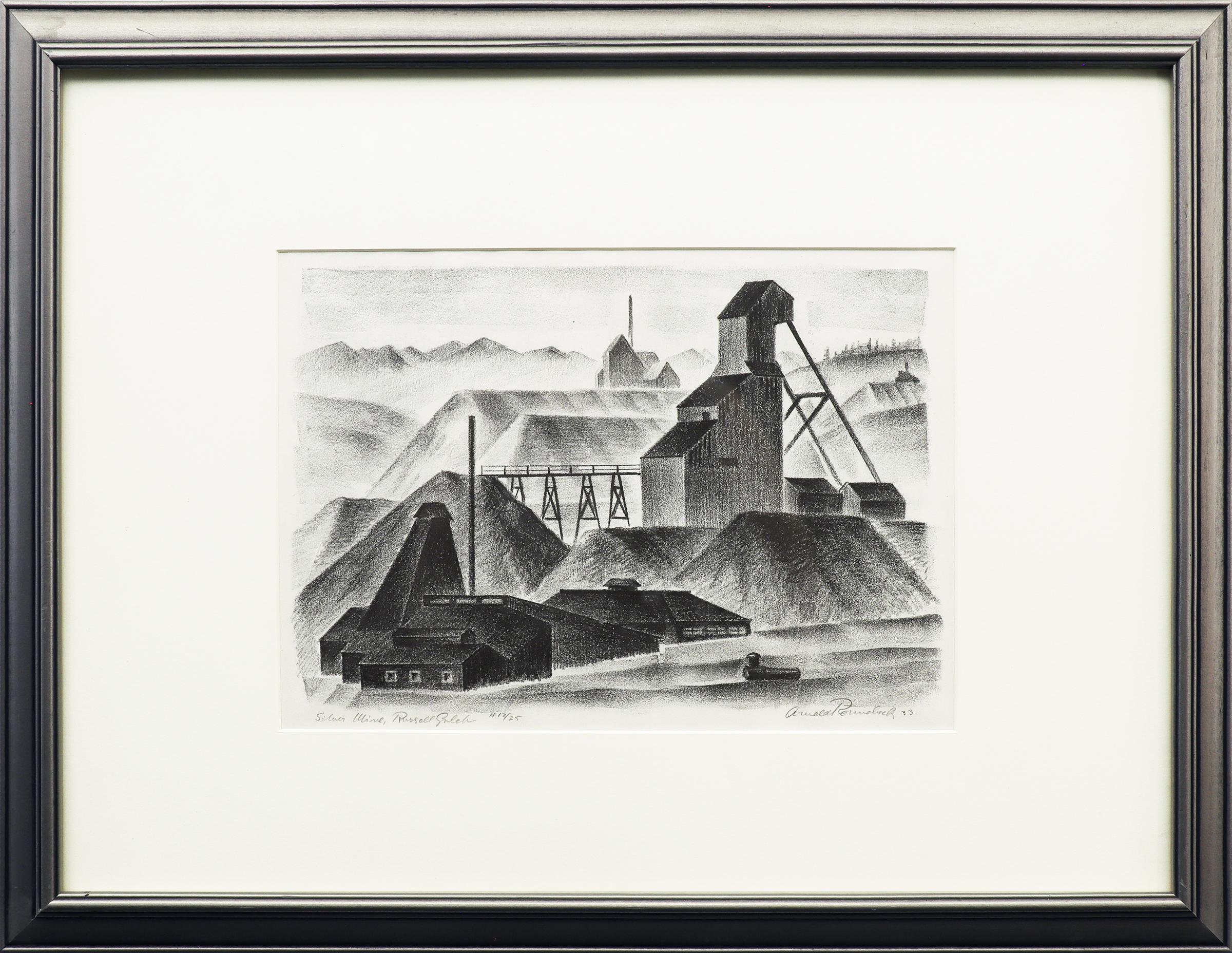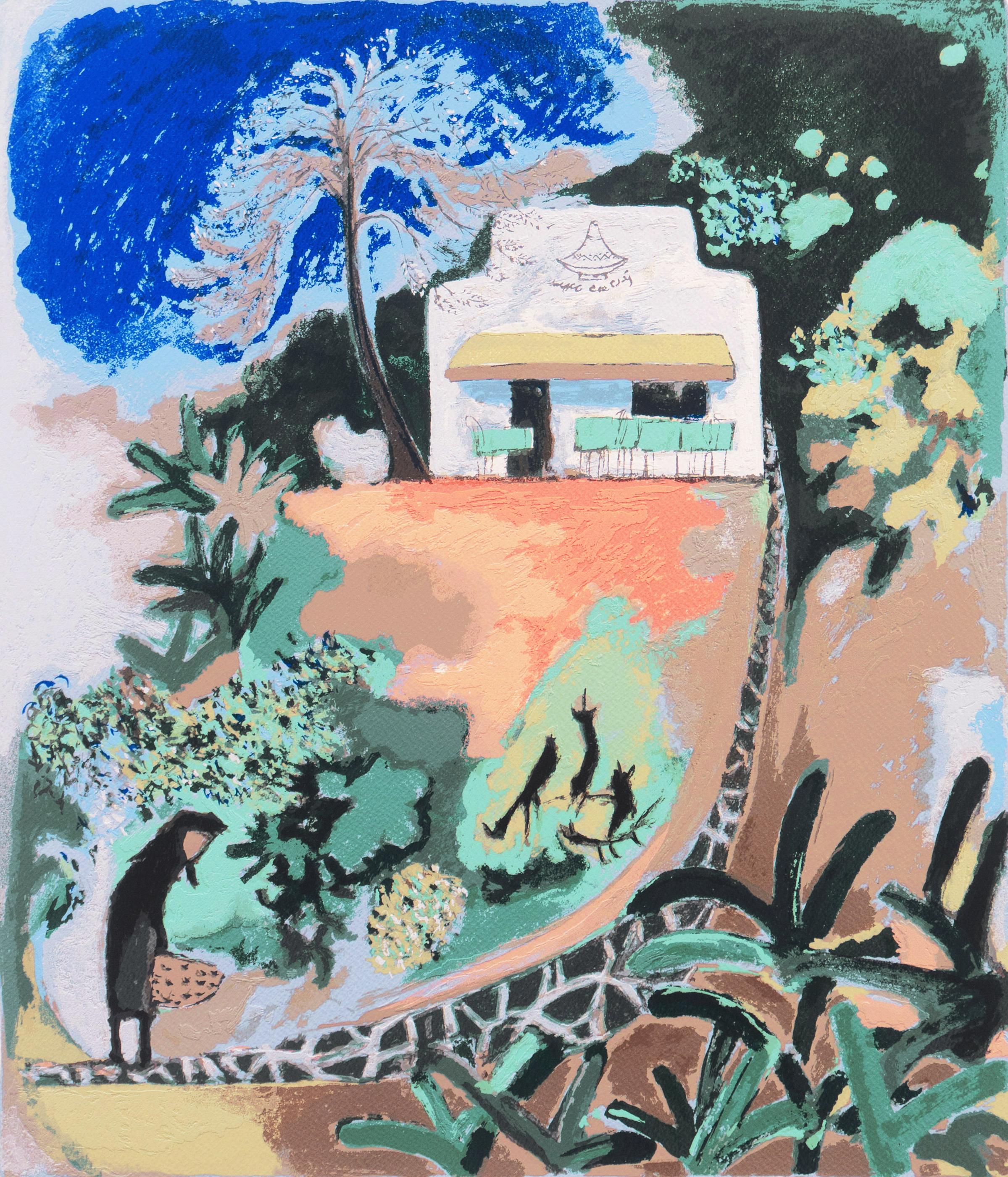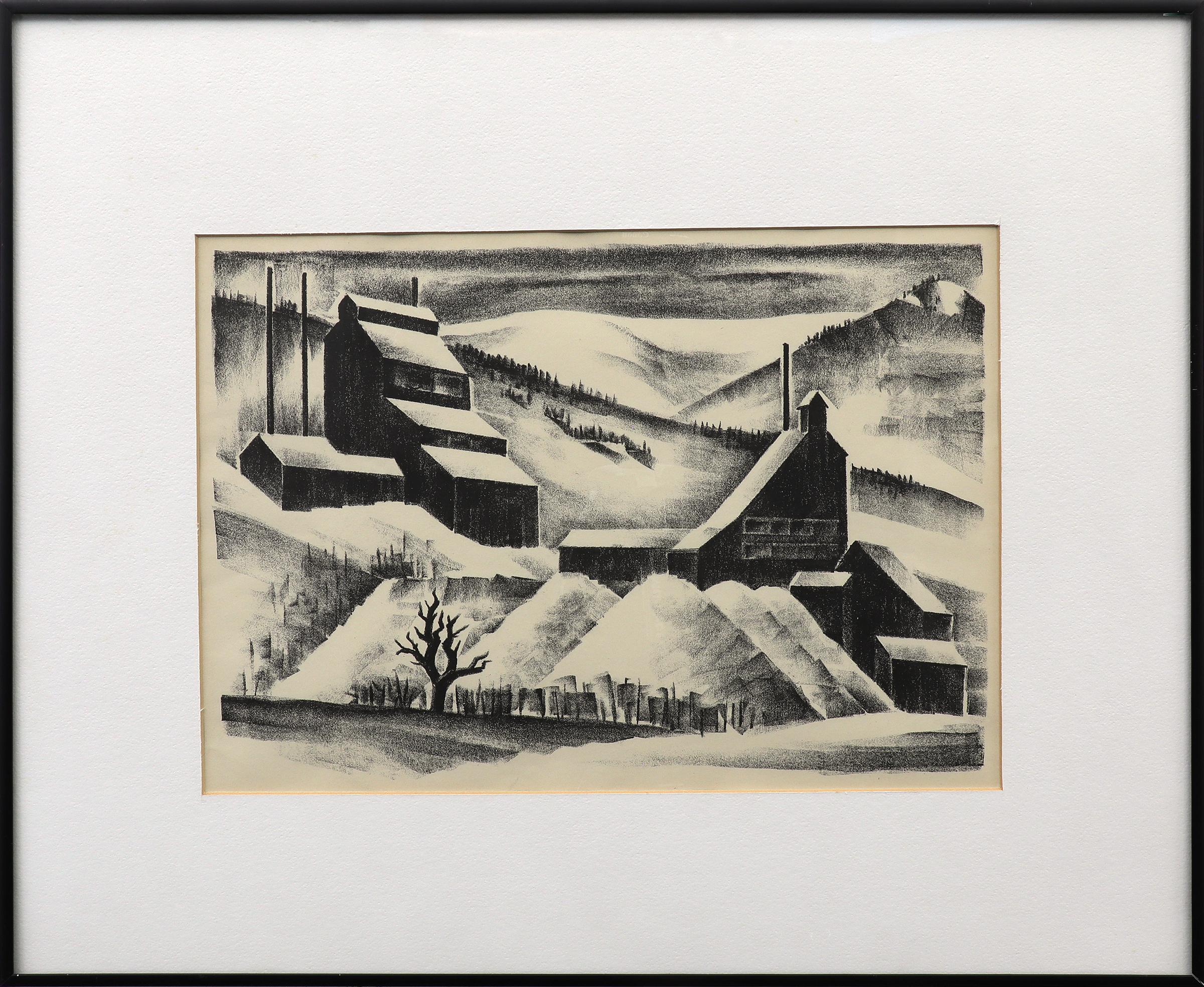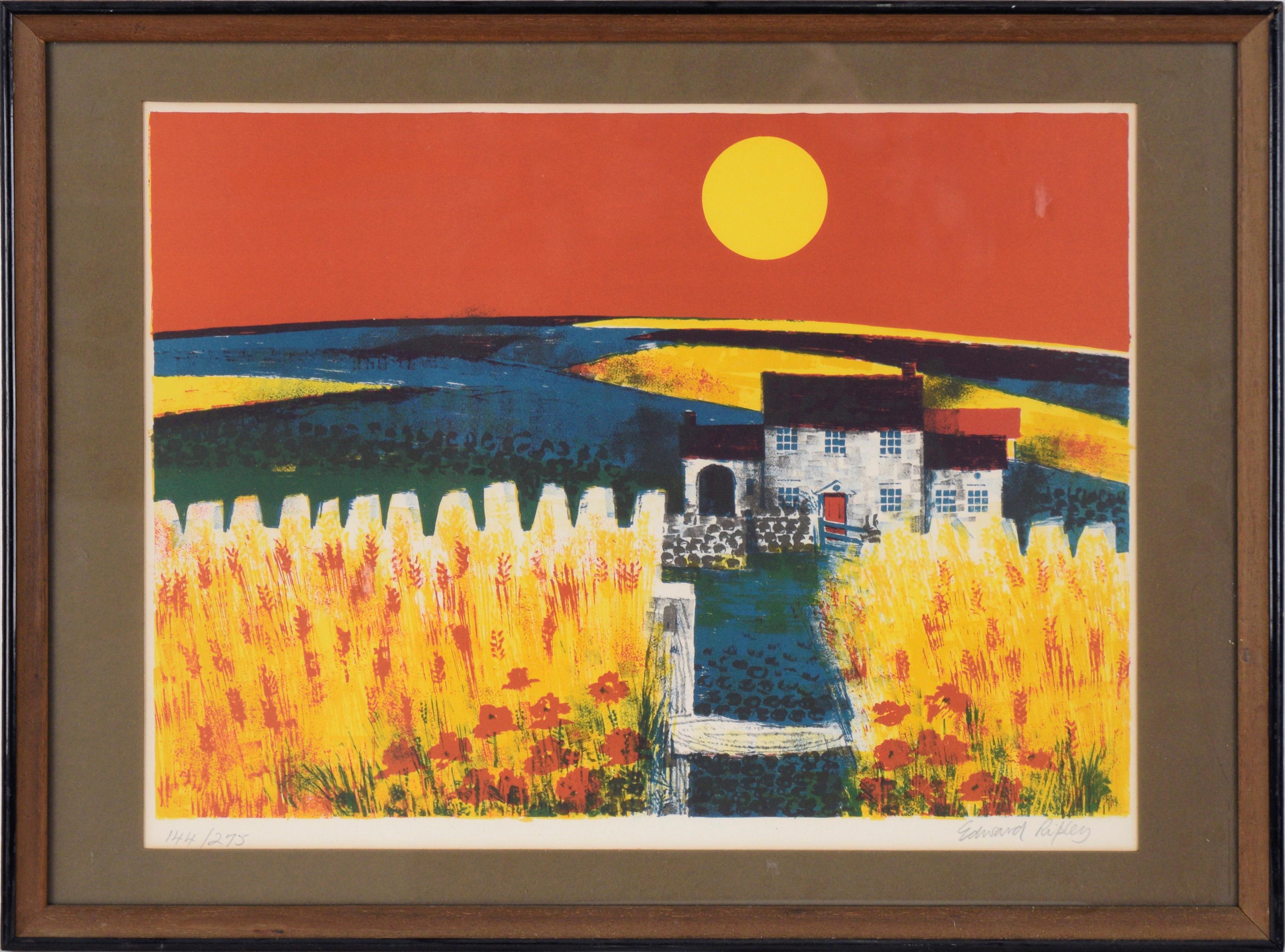Items Similar to "Untitled, " Joan Nelson, Modernist Trees and Clouds, Female Artist
Want more images or videos?
Request additional images or videos from the seller
1 of 8
Joan Nelson"Untitled, " Joan Nelson, Modernist Trees and Clouds, Female Artist1990
1990
About the Item
Joan Nelson (American, b. 1958)
Untitled, 1990
Color lithograph
16 x 16 inches
From the edition of 45
Provenance:
Mary Ryan Gallery, New York, 1991
Reader's Digest Collection
Joan Nelson was born in Torrance, California, a suburb of Los Angeles, where she lived until she was eleven. Her father was an aeronautical engineer and her mother a housewife who had studied art briefly and taught high school. The family moved to St. Louis, Missouri and she went to a junior college where she began to take art courses, then to a Catholic college and then she switched to Washington University where she obtained a Bachelor of Fine Arts degree in 1981.
Nelson's success story is one that could only have happened to a young artist in the past decade. Just six years ago, she was working part time as a cleaning woman. Now she lives in a row house in Brooklyn with artist Don Pouley, with whom she has lived since college. She works in a studio on the top floor of the house; she paints landscapes on finely finished pinkish wood blocks, working with all kinds of materials like wax, plaster and egg tempera.
Joan Nelson is a member of the School of Post-Modernist painting. Nelson has helped to raise the issue of the marginal status of female artists, their reputations and careers. Nelson creates landscape paintings, that are openly influenced by the work of earlier artists, Nelson points out that women artists can legitimately "redo" any and every movement within the arts because their original efforts within those movements have gone unnoticed.
Joan Nelson's work is included in the collections of the Museum of Modern Art and the Solomon R. Guggenheim Museum in New York; the Los Angeles County Museum of Art; the Hirshhorn Museum and Sculpture Garden in Washington D.C.; and the Museum of Fine Arts, Boston.
- Creator:Joan Nelson (1958, American)
- Creation Year:1990
- Dimensions:Height: 22 in (55.88 cm)Width: 22 in (55.88 cm)
- Medium:
- Movement & Style:
- Period:
- Condition:
- Gallery Location:New York, NY
- Reference Number:1stDibs: LU184129923712
About the Seller
5.0
Platinum Seller
These expertly vetted sellers are 1stDibs' most experienced sellers and are rated highest by our customers.
Established in 2021
1stDibs seller since 2022
63 sales on 1stDibs
Typical response time: <1 hour
- ShippingRetrieving quote...Ships From: Larchmont, NY
- Return PolicyA return for this item may be initiated within 3 days of delivery.
More From This SellerView All
- "New York - Taken from the Northwest angle of Fort Columbus, Governor's Island"Located in New York, NYNew York - Taken from the north west angle of Fort Columbus Governor's Island, 1846 Engraved by Henry Papprill after a sketch by F. Catherwood, published by Henry J. Megarey Hand-colored engraving on paper Image 16 x 26 1/2 inches Henry A. Papprill (1816–1903) was a British engraver. Noted as an aquatint engraver from 1840. His plates were published from 1840 till 1883 mainly by Ackermann of the Strand. Papprill was born in Holborn, London. Lived for much of his life at Wharton Street, Lloyd Square, London. Papprill is thought to have been based in New York City for brief period in the mid-1840s. His work in the USA appears to classify him as an American engraver but he was based and gained his reputation and bulk of his work in England. He produced a series of works for Ackermann & Co from 1840 beginning with four plates called "The Jolly Squire", with verses, after James Pollard. In the following years Papprill engraved a number of military plates for Ackermann as well a series of engravings of New York (1846-9) for H.I.Megarey (published in New York). The most notable of these are: "The North West Angle of Fort Columbus, Governor's Island" (the Catherwood-Papprill view) and New York from the Steeple of St. Paul's Church, Looking East, South & West." (The Hill-Papprill view) listed in the American Historical Prints - Early Views of American Cities, etc: I.N.Phelps Stokes & Daniel C. Haskell. New York Public Library 1932. Papprill also produced for Ackermann a series of sporting prints after G. H. Laporte between 1860 and 1865. These were entitled: Racing, Hunting and Coursing. He also produced a series of shipping prints...Category
1840s Landscape Prints
MaterialsAquatint, Engraving, Paper
- "Business-Men's Class, Y.M.C.A." George Bellows, Ashcan School PrintBy George Wesley BellowsLocated in New York, NYGeorge Bellows Business-Men's Class, Y.M.C.A, 1916 Signed, numbered "No. 41" and titled lower margin Lithograph on wove paper 11 1/2 x 17 1/8 inches Edition of 64 Provenance: Hirschl & Adler Galleries, New York Private Collection, Ohio Literature: Mason, 20. After his arrival from Columbus, Ohio in 1904, Bellows lived at the West Side YMCA. It was there that he met Eugene Speicher, another aspiring young artist who was to become his lifelong friend. Always interested in the anatomy of the human body, Bellows often satirized the various types who, while leading a sedentary life, feel compelled to devote a portion of their daily routine to physical self-improvement. Throughout his brief but illustrious career, George Wesley Bellows created striking scenes that documented ordinary American life in all its beauty and banality. Considered an American Realist, the artist eschewed embellishment, finding inspiration in the gritty boroughs of New York City, the rocky coastline of Maine, and, later, in his friends and family. Bellows garnered early recognition for his arresting portrayals of illegal prizefighting, dramatic works executed in dark tonal palettes that underscore the brutality of the violent sport. Bellows’ elderly Methodist parents hoped their son might pursue the ministry, a calling the extroverted athlete never received. The Columbus native competed on the baseball team at Ohio State University and also served as an illustrator for the college yearbook. In the fall of 1904—just months shy of his expected graduation—Bellows defied his father’s wishes and boarded a train to New York City in hopes of becoming a magazine illustrator like his idols Howard Chandler Christy and Charles Dana Gibson. Before leaving, he reportedly turned down an offer to play professional baseball with the Cincinnati Reds...Category
1910s Ashcan School Figurative Prints
MaterialsLithograph, Paper
- "Thanksgiving" Doris Lee, Family Genre Scene Interior, Americana, WPA, WoodstockBy Doris LeeLocated in New York, NYDoris Lee Thanksgiving, 1942 Signed lower right, titled lower left Lithograph on paper Image 8 3/4 x 11 3/4 inches Sheet 12 x 17 inches From the edition of 250 An American Scene pai...Category
1940s American Realist Interior Prints
MaterialsPaper, Lithograph
- "Hommage a Nobutaka Shikanai, " Zao Wou-Ki, Abstract Lithograph Mid-century PrintBy Zao Wou-KiLocated in New York, NYZao Wou-Ki (1920 - 2013) Hommage a Nobutaka Shikanai - 1991, (Agerup 354) Color lithograph on BFK Rives watermarked paper, full margins 24 x 18 1/4 inches Signed and titled in the sheet Published by Fuji Television Gallery, Tokyo Zao (Zhao) Wou Ki combines Oriental landscape abstraction with French influence. He was born in Beijing on February 13, 1921, and from the age of ten, Zao drew and painted with great freedom. He learned from his grandfather that calligraphy is an art when it transmits an emotion to the person looking at it. At age fourteen he enrolled at the School of Fine Arts in Hangzhou, where he remained for six years. He studied and then taught at the Hongchow National Academy of Fine Arts. In 1942, he organized an exhibition of works by his teacher, Wu Dayu, along with some of his own. In 1948, he moved to Paris where he has lived and worked ever since, although he has exhibited in New York City. He attended the Académie de la Grande Chaumière and lived at Rue du Moulin Vert nearby Alberto Giacometti's studio. Making the acquaintance of Hans Hartung, Nicolas de Staël, Pierre Soulages, Viera da Silva...Category
1990s Abstract Abstract Prints
MaterialsPaper, Lithograph
- "The Little Tree" Joan Mitchell, Abstract Expressionist, Female ArtistBy Joan MitchellLocated in New York, NYJoan Mitchell The Little Tree, 1992 Four color lithograph on wove paper Sheet 8 x 7 inches Published by Tyler Graphics. Mount Kisco, NY In unsigned edition...Category
1990s Abstract Expressionist Abstract Prints
MaterialsPaper, Lithograph
- "La Danse Barbare (from Les Saltimbanques), " Pablo Picasso, Figurative PrintBy Pablo PicassoLocated in New York, NYPablo Picasso (1881 - 1973) La Danse Barbare (from La Suite des Saltimbanques), 1905, printed 1913 Etching on Van Gelder Zonen wove paper Sheet 13 x 20 inches From the edition of 250...Category
Early 1900s Modern Figurative Prints
MaterialsPaper, Etching
You May Also Like
- The Road With Trees - Lithograph by Jacques Thévenet - Early 20th CenturyBy Jacques ThévenetLocated in Roma, ITThe Road With Trees is a print realized by Jacques Thèvenet in the early 20th Century. Lithograph on paper. Hand-signed, Numbered, edition of 6/40 p...Category
Early 20th Century Modern Landscape Prints
MaterialsPaper, Lithograph
- Frank Lloyd Wright's Ennis House, Los Angeles - Lithograph on PaperLocated in Soquel, CAFrank Lloyd Wright's Ennis House, Los Angeles - Lithograph on Paper Clean, modern lithograph of the Ennis House in Los Angeles by Frances Myers (American, 1936-2014). The Ennis House sits at the top of a small hill, cutting a strong line against a soft peach-colored sky. Wright's strong sense of balance is highlighted in this composition, with patterns and lines guiding the viewers eye in various directions around the piece. Numbered, titled, signed and dated along the bottom edge: 7/50 Ennis House - Los Angeles Frances Myers 1980 Paper size: 29.5"H x 38"W Print size: 24"H x 32"W Shipped rolled in a tube. Myers was born on April 16, 1936, in Racine, Wisconsin. She began her studies at the San Francisco Art Institute, but soon transferred to the University of Wisconsin–Madison where she earned a BS in 1962, and an MFA in 1965. Myers employed a variety of printmaking techniques in her career including "relief, photo-etching, and mixed media processes." Myers is best known for her prints depicting various buildings. She once said, “I don’t want to invent a building, I want to bring new life to a building.” Growing up in Racine, Myers was exposed to many of Frank Lloyd Wright's architectural works, and she paid tribute to this in her 1980 work The Frank Lloyd Wright Print...Category
1980s Modern Landscape Prints
MaterialsPaper, Ink, Lithograph
- Silver Mine, Russell Gulch (12/25) Abstract Black and White Print in MountainsBy Arnold RönnebeckLocated in Denver, COLithograph on paper titled 'Silver Mine, Russell Gulch (12/25)' by Arnold Ronnebeck, which is a black and white lithograph print of an oil painting by him of the same name. It shows a mine with a mountain ridge in the background. Presented in a custom frame measuring 20 ½ x 26 ½ inches. Image size measures 10 ¼ x 14 ¼ inches. Print is clean and in very good vintage condition - please contact us for a detailed condition report. Provenance: Estate of Arnold Ronnebeck Expedited and international shipping is available - please contact us for a quote. About the Artist: Modernist sculptor, lithographer and museum administrator, Rönnebeck was a noted member of European and American avant-garde circles in the early twentieth century before settling in Denver, Colorado, in 1926. After studying architecture at the Royal Art School in Berlin for two years beginning in 1905, he moved to Paris in 1908 to study sculpture with Aristide Maillol and Émile-Antoine Bourdelle. While there he met and befriended American modernist painter, Marsden Hartley, of whom he sculpted a bronze head that was exhibited at the Salon d’Automne in Paris in 1912 and the following year at Hartley’s solo show of paintings at Alfred Stieglitz’s Gallery 291 in New York. A frequent guest of Gertrude Stein’s Saturday "evenings" in Paris, she described Rönnebeck as "charming and always invited to dinner," along with Pablo Picasso, Mabel Dodge (Luhan) and Charles Demuth. After the outbreak of World War I in 1914, Rönnebeck returned to Germany where he served as an officer in the German Imperial Army on the front lines. Twice wounded, including in the Battle of Marne in France, Kaiser Wilhelm II awarded him the Iron Cross. During the war Hartley fell in love with Rönnebeck’s cousin, Lieutenant Karl von Freyburg, who was killed in combat. As a tribute to Freyburg, Hartley created Portrait of a German Officer (1914) now in the Metropolitan Museum of Art in New York. After the war Rönnebeck traveled in Italy with German writer, Max Sidow, and German poet, Theodor Daubler, doing a series of drawings of Positano and the Amalfi Coast that formed the basis for his lithographs on the subject. The death of his finacée, the young American opera singer Alice Miriam in 1922 and his own family’s increasing financial problems in post-World War I Germany led him to immigrate to the United States in 1923. After living briefly with Miriam’s family in Washington, DC, he moved to New York where he became part of the avant-garde circle around Alfred Stieglitz. His essay, "Through the Eyes of a European Sculptor," appeared in the catalog for the Anderson Gallery exhibition, "Alfred Stieglitz Presents Seven Americans: 159 Paintings, Photographs & Things, Recent & Never Publicly Shown, by Arthur G. Dove, Marsden Hartley, John Marin, Charles Demuth, Paul Strand, Georgia O’Keeffe, Alfred Stieglitz." In New York Rönnebeck began producing Precisionist-style lithographs of the city’s urban landscapes which he termed "living cubism." Some of them were reproduced in Vanity Fair magazine. Through Stieglitz he met Erhard Weyhe head of the Weyhe Gallery who, with its director Carl Zigrosser, arranged Rönnebeck’s first solo American exhibition in May 1925 at the gallery in New York. Comprising some sixty works – prints, drawings and sculpture – the show subsequently traveled on a thirteen-month tour of major American cities. Until the end of his life, the gallery represented him, along with other American artists Adolf Dehn, Wanda Gag, Rockwell Kent, J.J. Lankes, Louis Lozowick, Reginald Marsh and John Sloan. In the summer of 1925, as the guest of Mabel Dodge Luhan, Rönnebeck first saw Taos, New Mexico, which Marsden Hartley had encouraged him to visit. It was there that he met his future wife, Louise Emerson, an easel painter and muralist. A year later they were married in New York before relocating to Denver. He served as director of the Denver Art Museum from 1926 to 1930 where he invited Marsden Hartley to lecture on Cézanne’s art in 1928. Rönnebeck fostered the development of the museum’s collection of American Indian art and the curation of modernist art exhibitions. In addition to his work at the museum, he was professor of sculpture at the University of Denver’s College of Fine and Applied Arts from 1929 to 1935, and wrote a weekly art column in the Rocky Mountain News. His best known Denver sculptures from the late 1920s in bronze, copper, stone, wood and terra cotta include a reredos, The Epiphany, at St. Martin’s Chapel; The History of Money (six panels) at the Denver National Bank; The Ascension at the Church of Ascension; and the William V. Hodges Family Memorial at Fairmount Cemetery. At the same time he did a series of terra cotta relief panels for La Fonda Hotel in Santa Fe, New Mexico. In the 1930s his bas-relief aluminum friezes of stylized Pueblo and Hopi Indian Kachina masks...Category
1930s American Modern Figurative Prints
MaterialsPaper, Lithograph
- 'Mimosa Tree Restaurant', Aegean, Cyclades, Japanese Artist in Greece, Feral CatLocated in Santa Cruz, CASigned lower right, 'Hirano' for Yoshito Hirano (Japanese, born 1938) and created circa 1970; titled, verso, 'Mimosa Tree Restaurant'. Paper dimensions: 28...Category
1970s Modern Landscape Prints
MaterialsPaper, Lithograph
- Mine Near Continental Divide, Black White Colorado Mountain Landscape WinterBy Arnold RönnebeckLocated in Denver, COLithograph on paper titled 'Mine Near Continental Divide' by Arnold Ronnebeck (1885-1947) from 1933. Depicts a black and white winter scene of a mine in the mountains with snow on the rooftops and hillsides. Presented in a custom frame measuring 18 ¼ x 22 ¼ inches. Image size measures 10 ¼ x 14 ½ inches. Provenance: Estate of the Artist, Arnold Ronnebeck Expedited and international shipping is available - please contact us for a quote. About the Artist: Modernist sculptor, lithographer and museum administrator, Rönnebeck was a noted member of European and American avant-garde circles in the early twentieth century before settling in Denver, Colorado, in 1926. After studying architecture at the Royal Art School in Berlin for two years beginning in 1905, he moved to Paris in 1908 to study sculpture with Aristide Maillol and Émile-Antoine Bourdelle. While there he met and befriended American modernist painter, Marsden Hartley, of whom he sculpted a bronze head that was exhibited at the Salon d’Automne in Paris in 1912 and the following year at Hartley’s solo show of paintings at Alfred Stieglitz’s Gallery 291 in New York. A frequent guest of Gertrude Stein’s Saturday "evenings" in Paris, she described Rönnebeck as "charming and always invited to dinner," along with Pablo Picasso, Mabel Dodge (Luhan) and Charles Demuth. After the outbreak of World War I in 1914, Rönnebeck returned to Germany where he served as an officer in the German Imperial Army on the front lines. Twice wounded, including in the Battle of Marne in France, Kaiser Wilhelm II awarded him the Iron Cross. During the war Hartley fell in love with Rönnebeck’s cousin, Lieutenant Karl von Freyburg, who was killed in combat. As a tribute to Freyburg, Hartley created Portrait of a German Officer (1914) now in the Metropolitan Museum of Art in New York. After the war Rönnebeck traveled in Italy with German writer, Max Sidow, and German poet, Theodor Daubler, doing a series of drawings of Positano and the Amalfi Coast that formed the basis for his lithographs on the subject. The death of his finacée, the young American opera singer Alice Miriam in 1922 and his own family’s increasing financial problems in post-World War I Germany led him to immigrate to the United States in 1923. After living briefly with Miriam’s family in Washington, DC, he moved to New York where he became part of the avant-garde circle around Alfred Stieglitz. His essay, "Through the Eyes of a European Sculptor," appeared in the catalog for the Anderson Gallery exhibition, "Alfred Stieglitz Presents Seven Americans: 159 Paintings, Photographs & Things, Recent & Never Publicly Shown, by Arthur G. Dove, Marsden Hartley, John Marin, Charles Demuth, Paul Strand, Georgia O’Keeffe, Alfred Stieglitz." In New York Rönnebeck began producing Precisionist-style lithographs of the city’s urban landscapes which he termed "living cubism." Some of them were reproduced in Vanity Fair magazine. Through Stieglitz he met Erhard Weyhe head of the Weyhe Gallery who, with its director Carl Zigrosser, arranged Rönnebeck’s first solo American exhibition in May 1925 at the gallery in New York. Comprising some sixty works – prints, drawings and sculpture – the show subsequently traveled on a thirteen-month tour of major American cities. Until the end of his life, the gallery represented him, along with other American artists Adolf Dehn, Wanda Gag, Rockwell Kent, J.J. Lankes, Louis Lozowick, Reginald Marsh and John Sloan. In the summer of 1925, as the guest of Mabel Dodge Luhan, Rönnebeck first saw Taos, New Mexico, which Marsden Hartley had encouraged him to visit. It was there that he met his future wife, Louise Emerson, an easel painter and muralist. A year later they were married in New York before relocating to Denver. He served as director of the Denver Art Museum from 1926 to 1930 where he invited Marsden Hartley to lecture on Cézanne’s art in 1928. Rönnebeck fostered the development of the museum’s collection of American Indian art and the curation of modernist art exhibitions. In addition to his work at the museum, he was professor of sculpture at the University of Denver’s College of Fine and Applied Arts from 1929 to 1935, and wrote a weekly art column in the Rocky Mountain News. His best known Denver sculptures from the late 1920s in bronze, copper, stone, wood and terra cotta include a reredos, The Epiphany, at St. Martin’s Chapel; The History of Money (six panels) at the Denver National Bank; The Ascension at the Church of Ascension; and the William V. Hodges Family Memorial at Fairmount Cemetery. At the same time he did a series of terra cotta relief panels for La Fonda Hotel in Santa Fe, New Mexico. In the 1930s his bas-relief aluminum friezes of stylized Pueblo and Hopi Indian Kachina masks...Category
1930s American Modern Landscape Prints
MaterialsLithograph, Paper
- Farmhouse and the Wheat Field at Sunset - Landscape Lithograph in Ink on PaperLocated in Soquel, CAFarmhouse and the Wheat Field at Sunset - Landscape Lithograph in Ink on Paper Rich and saturated landscape by Edward Ripley (British, b. 1929). A vibrant yellow sun hangs over a farm landscape, set against a bold red sky. The foreground is made up of yellow and red wheat, with a few red poppies in the very front. A two story farmhouse stands...Category
1960s Modern Landscape Prints
MaterialsPaper, Lithograph, Ink
Recently Viewed
View AllMore Ways To Browse
Nelson And Nelson
Vintage Nelson
Nelson Original
House Of R And D
Readers Digest Vintage
Fiber Art Sculpture
Hermes Artists
Fantasy Sculpture
Used Music Boxes
Rose Figures
Abstract Outdoor Sculpture
Abstract Standing Sculpture
Colorful Modern Art Sculpture
Orange Books
Alter Ego
I Miss You
Landscape Lounge
Aluminum Painted Sculptures
